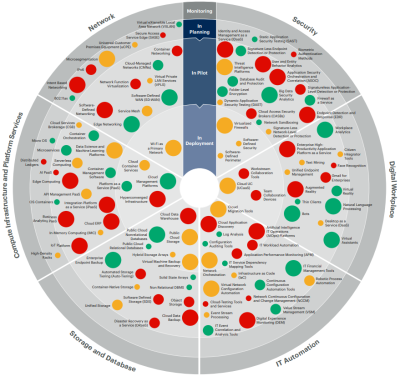IgniteTech is proud to share our advice in navigating the upcoming uncertainty of 2021 in this 4-part blog series compiled from expert resources, client feedback and our own experiences. Be sure to check out Part 1: Budget, Part 3: Workspace and Part 4: Software Substitutions over the coming weeks.
2020 has been a crazy year for the business world, as the global health crisis forced businesses to adapt to unprecedented challenges. Technology has fueled the ability for businesses to survive through the crisis, but as we approach an uncertain 2021 and whatever the next normal may be, forward-thinking organizations are using this as an opportunity to not just cut, but to optimize tech stacks to protect your organization for years to come.
The theme of how to accomplish this is balance. Specifically:
- Balancing costs & revenue
- Balancing immediate needs & tech debt
- Balancing innovation & risk
We know that it can be a difficult time to keep the long game in mind, as McKinsey summarizes:
“Most companies won’t have the management bandwidth and resources to take on a full-scale modernization in the next 12 to 18 months. By focusing on setting up or enhancing a cloud-based data platform and equipping agile teams with automated software delivery, CIOs can double, or even triple, development velocity in the short term.”
2021 is a perfect opportunity to take what you’ve learned in 2020 and make smart investments in your tech stack and the processes and philosophies that influence tech decisions. Put more simply, now that we’ve survived the crisis, let’s thrive in the future.
We have compiled our experience with IgniteTech customers alongside a number of reputable sources to develop this resource on how to make strategic tech stack decisions for 2021 and beyond, including specific action items by function to help this serve as a strategic document for your team.
Where We Are & Where We’re Going
Let’s start by looking to the experts to see where the current state of tech lies. This infographic from Gartner (preview below, click here to access full version) provides a roadmap of enterprise technologies, what stage they’re in, their enterprise impact and their risk:

It’s a good starting point to assess the progress that was made as a result of the pandemic, such as an acceleration in digital workspace tools with almost 82% in pilot phases compared to 44% in 2019.
Interest from outside the IT department (such as the C-Suite) has predictably made a large impact on priorities as well. Because the pandemic forced organizations to fundamentally rethink their priorities, outside parties were more likely to become interested in what would have only been preliminary departmental discussions. The shared interest builds momentum to implementing these changes and using the tech stack as a way to fundamentally change or streamline business processes.
Even though the main driver of change in 2020 has been speed in response to outside events, as these changes become implemented throughout your organization, it’s important to balance both resilience and speed. We will discuss both in more detail below, but as you take this opportunity to audit your tech stack and make changes for the future, look at technologies that can enable organizational speed without risking resilience nor creating tech debt.
Tech Debt
The term technical debt, or tech debt, refers to the idea that if you take shortcuts to push out code, you pay for it later with issues and fixes. The other way of looking at it is taking the time to build a solid foundation of code pays off with stability and sustainability in the future.
The pandemic exposed organizations with significant tech debt, as the patchwork tech solutions that may have been sufficient for the status quo became stressed with all the challenges brought by large portions of the workforce moving to remote work.
But even before the pandemic, many organizations took the threat of accelerating digitization seriously. According to McKinsey, “Even before the global health crisis hit, 92 percent of company leaders surveyed by McKinsey thought that their business model would not remain viable at the rates of digitization at that time.” The pandemic merely accelerated trends that were already threatening operations, forcing many organizations to come to terms with their tech debt all at the same time.
The good news is that the changes made in crisis mode have inspired permanent changes. McKinsey found that “75 percent of people using digital channels for the first time indicate that they will continue to use them when things return to ‘normal.’” Forrester predicts that “30% of firms will continue to accelerate their spend on cloud, security and risk, networks, and mobility” in 2021. The changes — at least philosophically — will stick. The question then is how to ensure that philosophical changes are supported by a sustainable tech stack that can continually service the speed, reliability and flexibility that is more than ever being ingrained into company culture.
Furthermore, the success of many organizations through 2020 can be attributed to the tireless work of IT professionals. As the Forrester podcast The Role Of Technical Debt In The New Normal discusses, this can lead to the opportunity for more strategic input for CIOs: “What could you do if we gave you some money and actually pressed on this digital mid- and back-office set of processes that we’ve been ignoring?” The pandemic forced many to understand the consequences of holding tech debt, which in turn creates an appetite to take care of those issues. Those leaders who were able to exceed expectations during the crisis will be more likely to make their case for fundamental changes that will set their organization up for success in any scenario.
The ultimate goal is to build a sustainable foundation that enables resiliency, democratized development and agility. That foundation will then be a competitive advantage for your organization, both by enabling you to react to unforeseen crises and also creating the ability to implement new technologies and processes.
There’s no telling what this decade of technological advancements will bring, so it’s up to tech leaders to ensure systems and processes are free of tech debt and can stand up to whatever competitive pressures may arise.
Speed
It’s a bit of a jump to move from tech debt to speed, because tech debt is often seen as a negative consequence of speed. That said, we want to focus on building speed into your tech foundation to prevent unintentionally building tech debt when responding to unpredictable situations.
As you are well aware, for many organizations, the pandemic has increased the speed of innovation and adoption of new technologies and practices. According to McKinsey, executives say “their companies have accelerated the digitization of their customer and supply-chain interactions and of their internal operations by three to four years. And the share of digital or digitally enabled products in their portfolios has accelerated by a shocking seven years.” Across the board, they found that businesses responded quickly, as shown by the chart below:

At IgniteTech, we’ve been consistently impressed this year by what our clients have been able to accomplish in compressed timeframes to keep their business rolling through tough times. But going into 2021, it’s extremely important to keep that energy moving forward and use it as a competitive advantage. Don’t go back to the old ways and old processes; instead, use that energy and your newfound organizational speed to keep employees happy and productive.
As you do that, prioritize technologies in your stack that will enable speed. That can come in the form of flexible technology that integrates well with your existing systems, or it could be infrastructure that supports overall speed across the organization, such as by automating manual processes or removing bottlenecks.
Work with tech partners that value speed and offer solutions that help you maintain that speed, realizing that technological breakthroughs — as well as crises — can come at any time. Your technology and your processes must be set up to rapidly adapt to any situation.
This focus on speed has shown real results this year: “Respondents reporting 25%+ organic revenue growth in the past 3 years, 72% were first in their industries to experiment with new technologies during the crisis, [and] 67% invested more than industry peers in digital-related capital expenditures.” Speed has benefited organizations through the widespread crisis management of 2020, and it will continue to benefit your organization in 2021 and beyond.
Budget
In our previous 2021 planning blog, we discussed how to balance crisis cost savings against maintaining long-term business goals. Obviously, the current uncertainty will limit the amount of budget available for many initiatives.
But with strategic thinking and a keen eye toward long-term success, the changes necessary for budgetary survival today can be an opportunity to truly reinvent the role of tech throughout your organization.
Be sure to look for areas where transformations, reallocations or optimizations of tech are preferable over cuts. And when possible, use cost savings toward investing in a tech stack that will be more resilient and flexible no matter the circumstances.

Action Items by Function
To ensure this guide is actionable, especially for those outside IT, we have included a few select action items for a variety of sectors and functions below. We have excluded budgetary concerns, since those are applicable to any sector, but check out our previous blog for a guide on how to get your 2021 budget in order.
These simple action items are designed as a starting point to get you thinking in the right direction for an optimized tech stack. You can then develop the next steps for your individual team and organization from there.
Marketing
-
Find tech that helps you reach a changing audience.
The workplace has changed in 2020. Make sure your martech stack can reach your audience, even if their working patterns, behaviors and preferences have changed.
-
Utilize your team’s time to create value.
Find tools that enable your team to collaborate and work intelligently even in changing work environments. Eliminate repetitive, manual procedures when possible, and simplify your stack to ensure your team is using all its time on activities that generate value.
-
Address marginal programs.
Marketing often has a hand in a broad variety of initiatives, some more effective than others. While taking this opportunity to reinvent your tech stack for 2021, be sure to critically assess those marginal programs that aren’t obviously a failure but also don’t create a ton of value. There may be opportunities to reallocate resources toward less mature programs that could generate more value if they had proper investment.
Sales
-
Respond to changes in communications expectations and preferences.
The majority of B2B buyers are happy with virtual sales (including sectors previously reliant on field sales), the majority of sellers believe their new model is as effective as the old and video communication is preferred to phones in all cases, according to McKinsey. Commit to this new virtual model, and invest in tech that enables your team to thrive in this environment.
-
Support a team navigating a changing landscape.
Going along with the above, your sales team is navigating an unknown environment. Make sure that your CRM software, remote collaboration and other tech allows your sales team to spend their time selling while keeping sales operations smooth.
-
Invest in predictive models and forecasting that respond to changing prospect behaviors.
One of the unheralded consequences of the pandemic for sales and marketing is the simple fact that changing workplaces have knock-on effects on many of the data sources that power a modern sales organization. Tools with adaptive models for tracking and predictive capabilities, using the latest information, AI and ML, should take priority as you assess your sales tech stack.
HR, Hiring & Recruiting
The next entry into this series covers workspace planning, including an in-depth discussion on remote working in 2021.
Operations-Heavy Sectors (Mining, Manufacturing, Logistics, Construction, Industrial, et al)
-
Prepare for the future of automation.
Many operations-heavy sectors and functions are ripe for automation. Make tech stack decisions that look toward the future of automation and build an infrastructure that will enable you to adapt as technologies develop.
-
Embrace artificial intelligence & machine learning.
AI & ML will power the next generation of technology in ops-heavy sectors, providing insights to optimize every step of the process. To that point, IgniteTech recently announced the release of IgniteTech Insights, a ML-powered AI service that leverages the data from operations-data-heavy sources to analyze patterns and optimize complex processes.
-
Invest in tech for training, building skills and reskilling.
As industry and technology evolves, workers may have to reinvent their skillset to keep up with the realities of their industry. For organizations in ops-heavy sectors, becoming an industry leader in training & development will help to better adapt to changing circumstances and find and retain top talent. Investing in tech that facilitates training & development will pay off down the road.
Conclusion
We hope this guide will help organize your thoughts as you prepare for an uncertain yet exciting 2021. At IgniteTech, we’ve used the principles both in how we support our customers as well as how we internally organize our team. We’re committed to 100% customer success and that means helping our customers in any way we can, like activating your IgniteTech Unlimited entitlement to simplify your tech stack or unlock your budget through cost savings. Customers leverage IgniteTech Unlimited in three ways: to add new capabilities, to cut costs on tech that they can replace through the IgniteTech Unlimited program and to augment their existing IgniteTech solution.
As mentioned above, our next installment of this blog series will cover workspace optimization for 2021 and beyond. In the meantime, please don’t hesitate to contact your IgniteTech client advisor at any time for an assessment of your tech stack for an optimal 2021.






